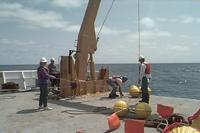| |
Science
Report:
Today we are
finishing up the last of our CTD casts before heading home. The final
casts will complete a circular pattern around Axial Volcano to better
define the outer limits of the hydrothermal plume. While these casts are
showing little indication of the plume, it is important to map the plume
limits in order to get a better understanding of the total effect it may
have on the environment.
Yesterday we deployed the
five moorings that will continue to collect data after we depart for home.
We deployed two basic types of moorings: MTR (miniature temperature recorder)
moorings, and multi-instrumented moorings. The latter of the two is a
complex mooring designed for the insertion of various instruments as we
deploy the mooring. We start off by lowering a 1500pound anchor over the
side, followed by an acoustic release. The anchor is lowered by spooling
a premeasured rope over a capstan, a device that mariners use to pull
in or let out lines such as mooring lines. At predetermined intervals,
we tie off the end of the line with the anchor and "break" the line, that
is disconnect the line at a spot where chain and shackles have previously
been inserted. We then place our instruments in these spaces, such as
the in situ pump that Dr. Baker talked about or current meters.
The current meters will
allow us to follow the ocean currents for the entire year while the mooring
is deployed. These data will tell us whether the current was carrying
the vent emissions towards or away from our instruments when they were
sampling.
You may wonder what happens
at the end of the line? We attach a ship's line to a pull release that
attaches to the last floats of the mooring, which would be the top of
the mooring as it floats in the water column. With a quick pull of the
line, as Carol can be seen doing, the whole array is sent quickly to the
bottom at the location that we want.
The second type of mooring,
the MTR, is much easier. We deploy this type of mooring anchor last. We
start by deploying our top floats first and "stream" them out behind the
ship. We use quarter inch kevlar line, which has predetermined spots to
attach the MAPR's or MTR's. We attach these with tie wraps and tape, which
are essential tools in the oceanographer's toolkit. At the end of these
moorings we attach our release and a 500pound anchor. When we reach our
predetermined spot, we lower the release into the water and literally
kick the anchor over the side. Moorings are a nice way to break up some
of the repetitive work of the CTD's and require close work between the
ship's deck crew, the officers on the bridge, and the science party.
Tomorrow we turn towards
home, and start the tedious task of packing everything away in an organized
manner, cleaning all the labs, and preparing to unload all of our gear
in Seattle.
|
|

Carol, teacher at sea, releasing one of the final moorings.
|
|

